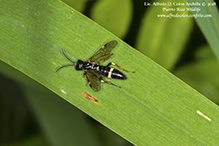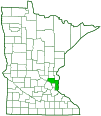Curled rose sawfly
(Allantus cinctus)
Conservation • Description • Habitat • Ecology • Distribution • Taxonomy
Conservation Status |
|||
| IUCN Red List | not listed |
||
| NatureServe | not listed |
||
| Minnesota | not listed |
||
Description |
Curled rose sawfly is a black, wasp-like, small to medium-sized, common sawfly. It is native and common in Europe and Asia. It was imported into North America and now occurs from the northeast and Midwest and in the west coast states. As a larvae it is an agricultural pest of roses and strawberries. Females are 5 ⁄16″ to ⅜″ (8.0 mm to 8.5 mm) long. Males are much smaller, ¼″ (6.4 mm to 6.7 mm) long. The thorax and abdomen are broadly connected. The head is black. The antennae are thread-like, cylindrical, and entirely black. They have 9 segments. Segments 7 and 8 are not broadened at the tip. The plate covering the thorax (pronotum) is black and shiny with a pair of small spots near the rear margin. The abdomen is black with a large triangular spot on the first segment and a thick white band covering more than half of the fifth segment. The triangular spot is larger on females than on males. The female has a saw-like ovipositor at the tip of the abdomen. The wings are mostly clear and evenly tinged dark brown. There is a dark brown mark on the leading edge of the forewing. The legs are long and slender and are mostly colored alike. The third segment (femur) of the front and middle leg is black. The femurs on the hind leg is white just at the base. The fourth segment (tibia) is brownish-yellow with a small white band at the base, giving the appearance of “white knees.” The larva is green or yellowish green above with tiny white dots, pale green or pale yellowish below. The head is orange, the eyes black. They have three pairs of legs on the thorax and at least six pairs of leg-like structures (prolegs) on the abdomen. Mature larvae are about ¾″ in length. |
Size |
Male: ¼″ (6.4 mm to 6.7 mm) Female: 5 ⁄16″ to ⅜″ (8.0 mm to 8.5 mm) |
Similar Species |
Habitat |
|
Ecology |
Season |
Two generations per year. Larvae from May to June. Adults through September. |
Behavior |
Slugs are found on the underside of leaves. As they eat, they skeletonize the leaf, consuming the soft tissue and minor veinlets, leaving the midrib and lateral veins. On the adult, the wings are held over the body when at rest. They hunt other insects often on umbellifers. |
Life Cycle |
The mature bores into the pith of the stem and pupates. Pupa overwinter in the soil. |
Larva Food |
Leaves of rose (Rosa spp.) and strawberry (Fragaria spp.) |
Adult Food |
Small insects |
Distribution |
||
|
Sources |
|
| 8/27/2025 | ||
Occurrence |
||
|
||
Taxonomy |
|
Order |
Hymenoptera (Ants, Bees, Wasps, and Sawflies) |
Suborder |
Symphyta (Sawflies, Horntails, and Wood Wasps) |
Superfamily |
Tenthredinoidea (Typical Sawflies) |
Family |
|
Subfamily |
Allantinae |
Tribe |
Allantini |
Genus |
Allantus |
Subordinate Taxa |
|
curled rose sawfly (Allantus cinctus cinctus) curled rose sawfly (Allantus cinctus nigritibialis) |
|
Synonyms |
|
Allantus cingulatus Dolerus cingulatus Dolerus varipes Emphytus cinctipes Emphytus cinctus Emphytus neglectus Tenthredo cincta Tenthredo cordigera |
|
Common Names |
|
banded rose sawfly curled rose sawfly |
|
Glossary
Femur
On insects and arachnids, the third, largest, most robust segment of the leg, coming immediately before the tibia. On humans, the thigh bone.
Pronotum
The exoskeletal plate on the upper side of the first segment of the thorax of an insect.
Tibia
The fourth segment of an insect leg, after the femur and before the tarsus (foot). The fifth segment of a spider leg or palp. Plural: tibiae.
Visitor Photos |
Share your photo of this insect. |
||
This button not working for you? |
||
Alfredo Colon |
 |
MinnesotaSeasons.com Photos |
|

Slideshows |
|

Visitor Videos |
Share your video of this insect. |
||
This button not working for you? |
||
|
Other Videos |
Psowacz różany - żerująca gąsienica. |
About
Published on Sep 11, 2017 Psowacz różany -Allantus cinctus |

|
Created: 4/16/2019 Last Updated: © MinnesotaSeasons.com. All rights reserved. |


